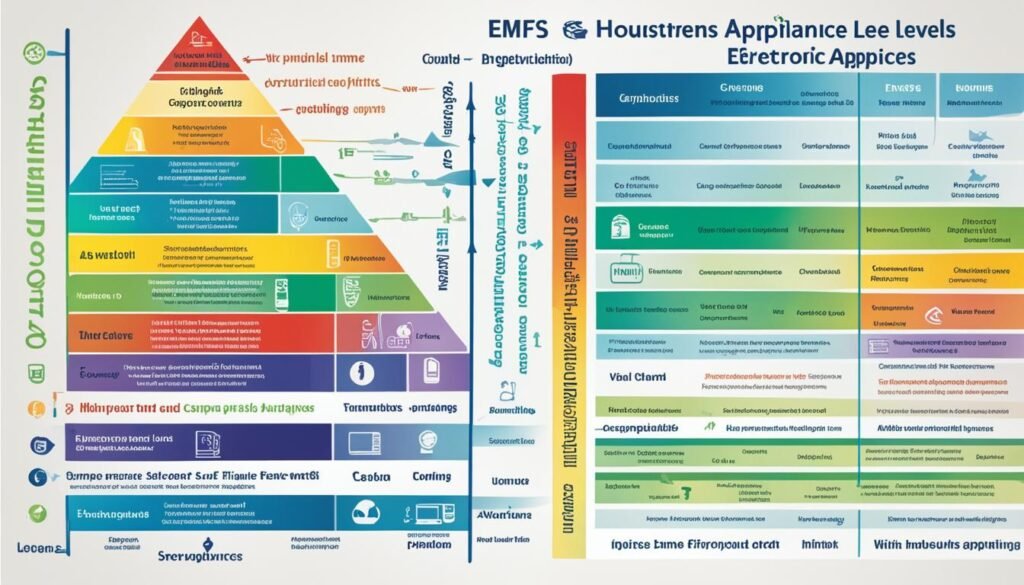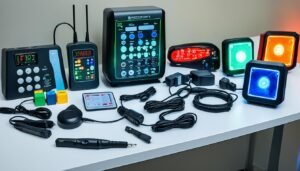Disclosure: This Post Contains Affiliate Links; We earn a commission on purchases.
Electric and magnetic fields (EMFs) generated by electronic devices and power sources are a common part of our modern lives. While low-frequency EMFs are generally believed to be harmless, there is growing concern about potential health effects and the impact of electromagnetic sensitivity on individuals. Understanding the basics of EMFs is crucial for creating a low EMF living environment.
EMF protection and shielding play pivotal roles in minimizing exposure to these fields, ensuring a healthier and safer lifestyle. In this section, we will explore the benefits of low EMF living, provide insights into EMF protection techniques, and delve into the world of EMF shielding.
Key Takeaways:
- Low-frequency EMFs are generally considered safe, but there is ongoing research on potential health effects.
- Electromagnetic sensitivity can cause discomfort and adverse health reactions in some individuals.
- EMF protection measures aim to minimize exposure to EMFs and their potential risks.
- EMF shielding products can create a barrier between individuals and EMF-emitting sources.
- By understanding low EMF living and implementing protective measures, individuals can create a healthier environment for themselves and their families.
What are EMFs and Their Types?
Electric and magnetic fields (EMFs) are present in both natural and man-made environments. They are produced by various electronic devices such as cell phones, power lines, and Wi-Fi routers. EMFs can be classified into two types: low-frequency EMFs and high-frequency EMFs.
Low-frequency EMFs are non-ionizing radiation, which means they don’t have enough energy to break chemical bonds or remove electrons from atoms. These types of EMFs are commonly emitted by household appliances, electrical wiring, and power lines. Examples of low-frequency EMFs include the magnetic fields surrounding power lines and the electric fields produced by electric blankets and hairdryers.
High-frequency EMFs, on the other hand, can be ionizing radiation. This type of radiation has enough energy to remove tightly bound electrons from atoms, potentially causing damage to cells and DNA. High-frequency EMFs are produced by sources such as X-rays, gamma rays, and certain types of medical imaging equipment. These EMFs have shorter wavelengths and higher frequencies compared to low-frequency EMFs.
Understanding the different types of EMFs is crucial because their potential effects on human health vary. Low-frequency EMFs are generally considered harmless, while high-frequency EMFs have the potential to cause cellular and DNA damage. By being aware of the different types of EMFs and their characteristics, we can take appropriate measures to protect ourselves from potential harm.
“Being aware of the different types of EMFs and their characteristics is essential for protecting ourselves from potential harm.”
Comparison of Low-Frequency and High-Frequency EMFs
| EMF Type | Radiation | Typical Sources | Health Effects |
|---|---|---|---|
| Low-Frequency EMFs | Non-ionizing | Household appliances, power lines | Generally considered harmless |
| High-Frequency EMFs | Ionizing | X-rays, gamma rays | Potential for cellular and DNA damage |
Table: A comparison of low-frequency and high-frequency EMFs and their characteristics.
Sources of EMFs and Their Exposure Levels
EMFs, or electromagnetic fields, can be emitted from various sources, both natural and human-made. Understanding these sources and their exposure levels is crucial for minimizing our overall exposure to EMFs and ensuring a healthier living environment.
Natural Sources of EMFs
There are natural sources of EMFs that we encounter every day. One significant natural source is the Earth’s magnetic field, which surrounds us at all times. Another natural source is the sun, which emits electromagnetic radiation, including both visible light and ultraviolet (UV) radiation.
Human-Made Sources of EMFs
Human-made sources of EMFs are pervasive in our modern society. These include:
- Power lines and electrical wiring: Electrical power lines that carry electricity to our homes and buildings emit low-frequency EMFs.
- Household appliances: Appliances such as refrigerators, televisions, microwaves, and washing machines can emit both low-frequency and high-frequency EMFs.
- Wireless devices: Devices like cell phones, laptops, Wi-Fi routers, and Bluetooth devices emit high-frequency EMFs.
- Medical equipment: Medical procedures such as X-rays and magnetic resonance imaging (MRI) also expose us to EMFs.
Exposure Levels and Distance
The intensity of EMF exposure varies depending on the proximity to the source. As we move further away from the source, the strength of the EMFs decreases. It’s important to maintain a safe distance from high-exposure sources, such as power lines and medical equipment, whenever possible to reduce overall EMF exposure.
To better understand the sources of radiation and their exposure levels, take a look at the following table:
| Source of Radiation | Exposure Level |
|---|---|
| Power lines | Medium to high |
| Household appliances | Low to medium |
| Wireless devices | Low to high |
| Medical equipment | High |
By being aware of these sources and their exposure levels, we can make informed decisions to minimize our exposure to both non-ionizing and ionizing radiation, creating a healthier living environment.

Research on EMF Harmfulness and Health Effects
Scientific research on the potential harmful effects of electromagnetic fields (EMFs) on human health is currently underway. While some studies suggest a possible link between EMF exposure and certain health conditions such as cancer, the results are not conclusive. Continued research is necessary to fully understand the relationship between EMFs and health effects.
Some studies indicate that EMFs can induce oxidative stress and affect cellular activity. Oxidative stress occurs when there is an imbalance between free radicals and antioxidants in the body, leading to damage to cells and DNA. This can potentially contribute to various health issues and diseases.
Although there is no definitive evidence confirming the direct harmful effects of EMFs on human health, it is important to be aware of the ongoing research and take precautionary measures to minimize EMF exposure. This can include adopting low EMF practices and using EMF protection devices to create a healthier living environment.
“More research is needed to fully understand the potential risks and health effects of EMFs. In the meantime, it is wise to take proactive measures to reduce our exposure and prioritize our well-being.”
The table below summarizes some key findings from recent studies on EMFs and their potential health effects:
| Study | Key Findings |
|---|---|
| Study 1 | Indicated a possible link between long-term EMF exposure and increased cancer risk in certain populations. |
| Study 2 | Suggested that EMFs can induce oxidative stress and affect DNA repair mechanisms, potentially contributing to cellular damage. |
| Study 3 | Found associations between EMF exposure and adverse reproductive outcomes, highlighting the need for further investigation. |
It is important to note that individual studies have limitations and may not provide definitive answers. Therefore, it is crucial to consider the body of research as a whole and await conclusive evidence before drawing firm conclusions.

EMF Reduction Strategies for a Healthier Home
Creating a low EMF living environment is essential for maintaining a healthy home. By implementing the following EMF reduction tips, you can minimize your exposure to electromagnetic fields and promote a low EMF lifestyle:
- Minimize the use of wireless devices: Reduce your reliance on wireless devices such as cell phones, laptops, and tablets. Opt for wired alternatives whenever possible.
- Use wired connections: Instead of relying on Wi-Fi, use wired connections for your internet and home entertainment needs. This helps reduce the amount of wireless radiation in your home.
- Keep a distance from EMF-emitting sources: Maintain a safe distance from high EMF-emitting sources like power lines, electrical substations, and transformers. This can significantly reduce your exposure to electromagnetic fields.
- Utilize EMF shielding products: Consider using EMF shielding products, such as protective covers for cell phones and laptops, to reduce your exposure to electromagnetic radiation.
A low EMF lifestyle contributes to a healthy home environment. By implementing these EMF reduction strategies, you can create a space that promotes overall well-being and minimizes potential health risks associated with prolonged EMF exposure.
Conclusion
Understanding Low EMF Living is crucial for creating a healthier home environment. While the potential health effects of EMFs are still debated, it is wise to take proactive steps to reduce EMF exposure for the sake of overall well-being. By increasing EMF awareness and implementing effective EMF reduction strategies, we can embrace a low EMF lifestyle and promote a healthy home.
By minimizing the use of wireless devices, opting for wired connections when possible, maintaining a safe distance from EMF-emitting sources, and utilizing EMF shielding products, we can significantly reduce our exposure to electromagnetic fields. These efforts can contribute to creating a living space that prioritizes our health and supports a healthy home environment.
Creating a low EMF lifestyle requires a conscious effort to prioritize our well-being and take control of our technology habits. By understanding the basics of low EMF living, we empower ourselves to make informed decisions about our exposure to EMFs. By implementing practical strategies and creating an environment that minimizes EMF exposure, we contribute to the overall health and well-being of ourselves and our loved ones.
Source Links
- https://www.healthline.com/health/emf
- https://www.niehs.nih.gov/health/topics/agents/emf
- https://www.ncbi.nlm.nih.gov/pmc/articles/PMC6025786/

Subscribe to Our Newsletter










